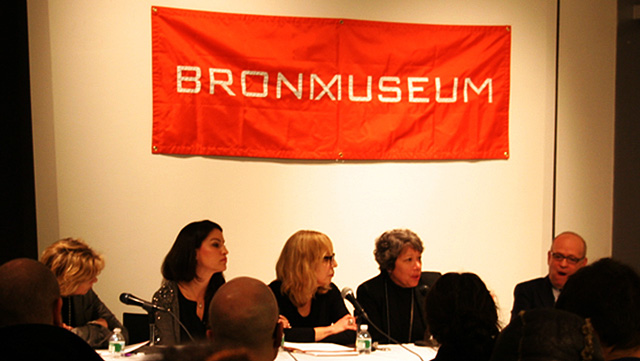The Museum Belongs to the People

The Bronx Museum of the Arts hosted a panel discussion in February to talk about the financial and political challenges facing cultural institutions today.
Bronx Museum Executive Director Holly Block was joined by representatives from a handful of other cultural institutions: the Queens Museum of the Arts, Creative Cities International, The FLAG Art Foundation, and Kaufman Vardy Projects.
The panel discussed the challenges of managing and funding art and community programs before an audience of about 75. “Funding sources are ever-changing, two steps forward, three steps back,” said Block.
Each of the panelists brought something different to the table when talking about attracting people to their institutions. Block said she makes the museum more accessible to the public by making admission to the museum free. She also offers shows and programming that invite the community to participate, such as a storytelling event.
The Queens Museum offers a variety of adult learning classes that are taught in many of the languages spoken throughout the borough. Director Tom Finkelpearl said it also partnered with the public library system to become the first museum to house its very own public library.
The FLAG foundation ties in its artwork with shows featuring celebrities such as Shaquille O’Neal, said organization director Stephanie Roach. It also uses fashion designers to engage the community.
At Creative Cities International, founder Linda Lees said she looks to the community itself to find out what the people living there want to see happen in their cities. “What we’re looking at is the human experience of the city,” said Lees, “Not everybody categorizes as artistic or creative, but they are part of the texture of the fabric of the city and we need all of them.”
In a study FLAG conducted, Roach asked people their thoughts on the cooperation between cultural centers and the community. She said that in the 35 cities that were surveyed, over half of the respondents said it was very important. “They would talk about kind of mixed use [like the public library and Queens Museum],” said Roach. “I think this idea of looking at institutions and organizations in the community, working together, set the model for other things that they wanted to see.”
Partnerships are a big part of generating attendance and funding for these institutions and that’s something all the panelists agreed on. “I do believe and am an advocate for collaboration and partnership,” said Block. “It’s much better to work with three like-minded institutions to create a project and share funding sources. Then you’re not isolated by yourself trying to raise all this money to do a project.” Block said she also depends on renting space at the museum for events like birthdays, weddings, and community board meetings. And added bonus, she added, they are great way to meet new people.
Queens Museum Director Tom Finkelpearl said that organizations should collaborate with institutions that share the same mission. “The idea of openness at Queens Museum is not to have a space, but to have space for social mixing, a place that feels comfortable for a lot of people across the board.”
In a time of competing demands on funding, Finkelpearl said organizations needed to come up with ideas to distinguish themselves, rather than duplicating other cultural institutions. “If you have something that differentiates you from other places…then aspire to do what you do better than everyone else,” said Finkelpearl. This, he said, would prevent multiple institutions from competing for the same funds.
At FLAG, an exhibition space for contemporary art in Chelsea, Director Stephanie Roach works closely with The Harlem Children Zone, as well as other schools, to drive attendance. “I think trying to promote and encourage this cross-pollination between art and other types of areas of culture has been a really amazing experience,” said Roach. “I think with that experience people keep coming back.” Roach said she tries to bring new artists to the public’s attention with a summer residency program.
The group discussed the future of the arts and artists in the city, which some felt was being threatened by cost of living in the area. “I think that the two fundamental problems facing New York City in the arts are student debt and housing,” said Finkelpearl. “It is too expensive. If we don’t have the artists, and the artists start to leave…then what?”
Block suggested going through local government to make a change and preserve the arts. “Tax laws for artists, I would start right there,” she said, “ I think you deserve equal equitable tax status for donations just like individual collectors. I think the way it starts is by talking to people.” Block said she walks the halls on state and federal level. Anyone who feels strongly about the arts should, she said.
“I’m a firm believer that government should support culture and that we really should have art everywhere,” said Block, “It’s extremely important.”
